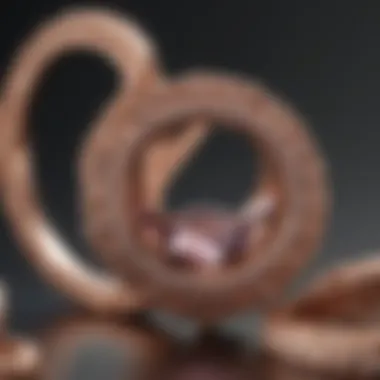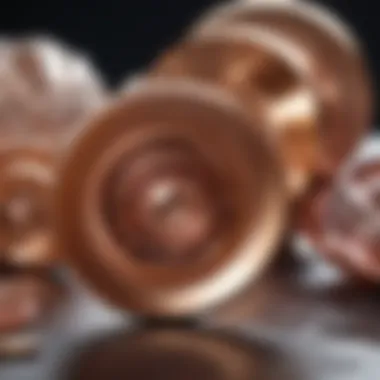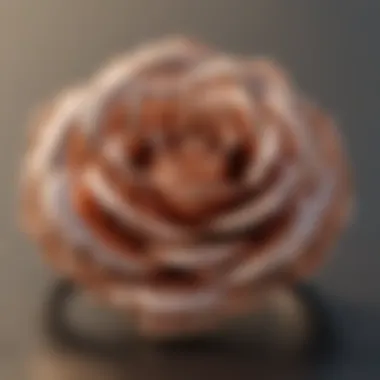Understanding Rose Gold: Composition and Authenticity


Intro
Navigating the world of gold often leads to a conversation about rose gold. Its romantic hue has captured the hearts of consumers worldwide, becoming a popular choice among jewelry enthusiasts and designers. But what exactly is rose gold? Why does it stand out in a market saturated with gold, silver, and platinum? This exploration is not just about aesthetics; it's about understanding the materials, their stories, and what makes them authentic.
Overview of Gemstones and Minerals
In order to appreciate rose gold, one must first grasp the broader context of gemstones and minerals. While gold has been prized for centuries, the gemstones associated with it enhance the allure of various ornaments, rings, and fine jewelry. These materials have a rich history and profound significance in many cultures.
History of Gemstone and Mineral Use
Historically, gemstones and minerals have been used for more than mere decoration. They symbolize power, wealth, and religion across civilizations. The Egyptians adorned themselves with lapis lazuli, believing it to hold protective qualities. Similarly, the Romans favored emeralds and sapphires, marking their social status. Rose gold, an alloy of gold and copper, emerged later but quickly became favored for its warm, inviting shade.
Significance in Culture and Society
The significance of gemstones extends beyond their physical properties. They often embody emotional connections, mark significant life events, and serve as tokens of love and friendship. With rose gold, many attribute its popularity to the aura of romance it exudes. Wearing rose gold jewelry often conveys a sense of elegance and affection, making it a cherished option for engagement rings and gifts.
The Composition of Rose Gold
Understanding rose gold requires a closer look at its composition, which defines its character and authenticity. Typically, rose gold consists of a mixture of gold, copper, and sometimes silver. The proportion of these metals affects both the color and durability of the final product. Most frequently, these alloys are described in karats; for instance, 18K rose gold includes 75% gold and 25% copper.
Varieties and Formulations
Not all rose gold is created equal. There are variations in formulations that lead to different shades and characteristics. Some manufacturers may use different copper contents, resulting in a range from a subtle pink to a deeper red hue. It's essential to recognize that the higher the copper content, the darker the rose tone.
Unveiling Authenticity in Rose Gold Products
With the rise in popularity of rose gold, consumers must be equipped to discern between authentic and imitation products. This is where understanding industry standards and consumer perceptions becomes vital. Generally, reputable jewelers will provide certificates of authenticity, verifying the gold content and its alloy composition. Moreover, recognition of hallmark stamps on jewelry can offer additional confirmation of quality and authenticity.
"Authenticity in jewelry doesn’t just pertain to the materials used; it encompasses trust in the brand and the craftsmanship as well."
Intro to Rose Gold
Rose gold's rising stature in the jewelry world is not simply about its aesthetic appeal. Its blend of warm hues and versatility has captured the hearts of many. The uniqueness of rose gold lies in its composition, which intricately combines gold with copper, producing a delicate pink tone that manages to be both luxurious and approachable. Understanding this alloy properly enables consumers, jewelers, and collectors alike to make informed decisions while navigating the market.
What Is Rose Gold?
At its core, rose gold is an alloy mainly comprised of gold and copper. The percentage of copper used in this blend determines the shade of pink, which ranges from a light blush to a deep, almost reddish hue. Typically, rose gold is made by mixing 75% gold with 25% copper (in a 18K formulation), creating a soft and romantic appearance.
This particular alloy has several benefits. For starters, rose gold is not only visually attractive but also durable. The addition of copper enhances the strength of gold, making it suitable for everyday wear. Many people also find its unique color a suitable match for a variety of skin tones, stemming from its warm undertones that blend beautifully with both cool and warm color palettes.
Historical Context of Rose Gold
The history of rose gold traces back to Russia in the 19th century when it was initially called "Russian gold". Tsarist goldsmiths pioneered its creation by mixing gold with copper to achieve a rich, rosy tint. It became a staple in Orthodox crosses and other religious artifacts, symbolizing a golden hue that attracted religious fervor and stylistic sensibility alike.


As the years rolled on, rose gold experienced fluctuations in popularity, notably witnessing a renaissance in the early 20th century during the Art Nouveau and Art Deco movements. Artisans favored it for its romantic and vintage aesthetics, incorporating it into elaborate rings and necklaces meant to express emotion and sentiment. It caught the hearts of the fashion-conscious, primarily due to its ability to reflect the cultural zeitgeist and evoke nostalgia.
Today, rose gold retains its charm across generations. Its revival in contemporary jewelry design shines a spotlight on its allure, making it a preferred choice for engagement rings, bracelets, and other adornments. Jewelers often tout its durability along with its beauty, making it a popular selection for individuals seeking both style and practicality in their accessories.
"Rose gold isn’t just a color, it's a timeless statement in the world of jewelry that balances both history and modernity, drawing every eye that crosses its path."
In summary, understanding rose gold involves recognizing its material composition and historical significance. This knowledge not only enhances the appreciation for this unique alloy but also arms consumers with the information necessary to identify authentic pieces in a market filled with alternatives.
Composition of Rose Gold
The composition of rose gold plays a crucial role in defining its distinct character and appeal. Unlike the traditional yellow gold or white gold, rose gold's unique pinkish hue derives from its specific alloy components. This section aims to unpack the elements that make up rose gold, shedding light on its properties and the benefits of its composition that make it a preferred choice in jewelry design.
Understanding Alloys
At its core, rose gold is an alloy, which means it's a mixture of gold and one or more metals. Typically, this blend includes copper and a lesser amount of silver or palladium. The proportion of these metals can vary, altering the color and properties of the final product. For instance, a higher ratio of copper yields a deeper rosy appearance while a higher silver content brings out a softer tone.
It's important to grasp how the alloying process not only contributes to color but also to the metal's flexibility and durability. Alloys can be quite resilient, which makes rose gold jewelry less prone to scratches compared to its pure gold counterparts. This quality is especially valuable to consumers who wish to wear their pieces daily without worrying about wear and tear.
Copper's Role in Rose Gold
Copper is a pivotal player in the composition of rose gold. It not only influences the color, but it also adds strength to the overall alloy. The reddish tint associated with rose gold is largely attributed to the copper content, and different karat levels will exhibit varying shades of rose.
When copper is introduced into the alloy, it also alters the melting point and workability, making it easier for jewelers to craft intricate designs. While some might be concerned about the potential for skin reactions, it's worth noting that rose gold typically contains less nickel, which is a common allergen found in white gold alloys. Thus, even those with sensitive skin may find rose gold a more comfortable option.
Gold Purity and Karat Ratings
Gold purity is expressed in karats, indicating the proportion of gold in an alloy as opposed to other metals. In the case of rose gold, you might encounter it in 10K, 14K, or 18K formats, with 24K representing pure gold. As you climb the karat ladder, the gold content increases, leading to a richer hue, yet there's also an associate increase in softness, making the piece more susceptible to scratching.
The following are common karat ratings in rose gold and their corresponding gold content:
- 10K Rose Gold: 41.7% pure gold and 58.3% alloy metals
- 14K Rose Gold: 58.3% pure gold and 41.7% alloy metals
- 18K Rose Gold: 75% pure gold and 25% alloy metals
Understanding these ratings not only helps consumers make informed decisions regarding their purchases but also provides insight into the inherent value of rose gold products. With ongoing trends favoring a marriage between style and functionality, the composition and specific gold purity of rose gold continue to win the admiration of jewelry enthusiasts and collectors alike.
Types of Rose Gold
Understanding the different types of rose gold is crucial for anyone exploring this exquisite metal. Rose gold is celebrated not just for its aesthetic appeal but for its versatility in jewelry design. Each variation in its hue can affect the overall look, compatibility with other materials, and even the meaning the wearer associates with it.
Different Shades of Rose Gold
The color of rose gold can vary significantly, leading to distinct types based on the ratio of gold to copper. Let's break it down:
- Classic Rose Gold: This traditional mix combines 18 parts gold, 6 parts copper, and a pinch of silver, showcasing a soft, romantic hue. Jewelers often favor this ratio for engagement rings and other romantic pieces.
- Red Gold: With a higher copper content, red gold presents a vibrant, fiery tone. This version can be spotted in bolder, statement pieces that catch the eye immediately.
- Pink Gold: The lightest and most subtle of the shades, pink gold features less copper in the alloy. This shade is ideal for delicate and feminine designs, often seen in dainty necklaces and rings.
"The beauty of rose gold lies in its ability to change tone depending on its composition—making it as unique as the person who wears it."


Each of these colors not only lends a different aesthetic appeal but also caters to individual preferences and skin tones. When choosing rose gold, one must consider how the shade complements their unique style and persona.
Comparative Analysis with Other Golds
When you set rose gold alongside yellow gold and white gold, each variant brings something distinct to the table.
- Yellow Gold: The classic staple, yellow gold’s warm, rich color comes primarily from its inherent gold content. It’s often associated with traditional jewelry and is a popular choice for timeless pieces.
- White Gold: Known for its modern, sleek look, white gold gets its finish from rhodium plating. While stunning, it can require more maintenance—after all, rhodium can wear off, needing periodic re-plating.
- Rose Gold: The gentle pinkish hue of rose gold can create a soft contrast, making it an appealing choice against different skin tones. Unlike white gold, it does not require the same upkeep, and the richness of its copper content can match well with both contemporary and vintage styles.
Choosing between these metals can hinge on personal taste, skin tone, and how the piece is meant to be worn. Whether you gravitate towards the boldness of red gold or the subtleness of pink gold, understanding the characteristics of each can facilitate an informed choice.
Market Perception of Rose Gold
The market perception of rose gold holds significant weight in understanding its acceptance and value among consumers and industry professionals. Rose gold is not merely a trend; it embodies a blend of aesthetics, symbolism, and craftsmanship that appeals to a broad audience. The growing preference for this metal is influenced by various factors, such as its unique coloring, historical ties, and its perceived status in the jewelry market.
Popularity Trends in Jewelry
In recent years, rose gold has surged in popularity, becoming a staple choice for engagement rings, wedding bands, and fashion accessories. This newfound love for the warm pink hue can be attributed to several elements:
- Fashion Influences: Celebrities and influencers showcasing rose gold items have dramatically boosted its visibility and desirability.
- Versatility: Its distinct color harmonizes well with various gemstones and metals. Many jewelers use it creatively, offering a fresh alternative to traditional yellow and white gold.
- Symbolism: Rose gold is often linked with sentiments of love and affection, making it a favorite for romantic gifts. Its rose-like tint evokes feelings of warmth, beauty, and elegance, enriching its appeal.
- Technological Advances: Advances in alloying techniques have improved the durability and availability of rose gold. More brands and jewelers can produce high-quality items at competitive prices.
These factors contribute to a robust trend where rose gold is not just a passing fad; it's woven into the fabric of contemporary jewelry design. While other metals maintain their market presence, rose gold has carved out a substantial niche, captivating hearts and minds.
"The increasing preference for rose gold reflects a broader trend towards individuality and personal expression in jewelry choices."
Consumer Awareness and Misconceptions
Even with the growing acceptance of rose gold, misunderstandings abound around its nature and quality. Some consumers still equate rose gold with lower quality due to its copper content. Such assumptions can lead to undervaluation of the metal's intrinsic qualities. A clearer understanding can dispel these myths:
- Karat Ratings: Many consumers falsely believe that only higher karat metals offer good quality, but rose gold's composition effectively showcases both gold and copper's best attributes over time.
- Durability Concerns: There's a misconception that rose gold is too soft due to its copper content. While it's true that copper makes it softer than some alloys, high-quality rose gold is durable enough for everyday wear.
- Color Variance: New buyers might struggle to differentiate quality levels based on color. While different manufacturers target specific shades, the final rose gold hue is influenced by the ratio of gold to copper, which can vary widely.
Educating consumers about these facts enhances their appreciation of rose gold. Through informed conversations, both consumers and jewelers can foster a better understanding of this alluring metal. As rose gold continues to shine in the jewelry market, addressing these misconceptions will be vital for its sustained popularity.
Authenticity of Rose Gold
Understanding the authenticity of rose gold is essential for anyone diving into the world of this unique metal. Not only does it carry a distinct aesthetic appeal, but distinguishing genuine rose gold from counterfeit materials or inferior alloys can have lasting impacts on your investment and satisfaction as a consumer. Authenticity matters, particularly when you’re considering items that will be worn, gifted, or collected. The key elements surrounding rose gold's authenticity are its composition, certification, and how it stands against industry norms.
How to Identify Genuine Rose Gold
Identifying genuine rose gold can be a bit like untangling a web. However, there are several telltale signs and approaches to help you avoid getting caught in a shiny trap.
- Check the Markings: Authentic rose gold jewelry should have engravings indicating its karat and purity. Standard markings include 10K, 14K, or 18K. If a piece is labeled "gold-plated" or has no markings, it may not be authentic.
- Color and Tone: The rich hue of genuine rose gold can vary from a subtle pink to a deeper reddish tone depending on the copper content. If the color appears uniform and strikingly shiny, it might be an indication of plating rather than solid material.
- Magnet Test: Pure gold is not magnetic. If your supposed rose gold piece is attracted to a magnet, it likely contains metals that diminish its authenticity.
- Acid Test: Jewelers often use a specific acid test to determine gold content, including rose gold. A small sample is scratched, and acid is applied to see if there is a reaction.
- Professional Appraisal: When in doubt, seek the insight of a qualified jeweler. A professional appraisal can provide reassurance about the piece’s material and value.
"When it comes to rose gold, it's better to be safe than sorry. A small investment in professional insight can save you headaches later on."


Industry Standards for Rose Gold
Navigating the complex landscape of industry standards surrounding rose gold can empower consumers in their jewelry decisions. Standards generally focus on the composition and purity of the gold used.
- Karat Rating: Higher karat ratings indicate a greater proportion of gold. For rose gold, common ratings are usually between 10K to 18K. The higher the karat, the less copper content, resulting in a lighter pink hue.
- Quality Control Regulations: Many countries enforce regulations to ensure that gold jewelry is accurately labeled and meets specific purity standards. Familiarizing oneself with these regulations, especially if purchasing internationally, can be beneficial.
- Certification Transparency: Certificates from credible organizations can verify the authenticity and value of rose gold items. Reputable sources like the Gemological Institute of America provide essential insights into standards of gold quality.
- Assay Marks: These marks stamped on the jewelry indicate testing by an independent body. They assure consumers that the piece has met regulated standards for quality and authenticity.
By being informed about how to spot genuine rose gold and understanding industry standards, consumers can confidently engage with this beautiful metal. Whether for adornment or collecting, recognizing authenticity adds layers of significance to the purchasing experience.
Caring for Rose Gold Jewelry
When it comes to rose gold jewelry, caring for these pieces is paramount to maintain their beauty and longevity. Unlike traditional yellow gold, rose gold has a unique alloy composition that can affect its durability. Understanding how to properly care for your rose gold items ensures they sparkle and remain alluring through the years.
Maintenance Tips
Regular maintenance is essential to keep your rose gold jewelry looking its best. Here are some practical tips to consider:
- Avoid Exposure to Harsh Chemicals: Products like chlorine or bleach can damage the metal. Remove rings before swimming or cleaning.
- Clean with Care: Use a soft cloth to gently wipe down your pieces after wearing them. For a deeper clean, use warm water mixed with a mild soap. Avoid abrasive materials that could scratch the surface.
- Store Properly: When storing rose gold items, use an enclosed box or a soft pouch to protect them from scratches. It's wise to keep them separate from other jewelry to avoid any unwanted friction.
- Professional Cleaning: Consider taking your rose gold jewelry to a professional jeweler for a thorough cleaning at least once a year. They can also check for any loose stones or potential damage.
By implementing these maintenance strategies, wearers can not only prolong the life of their rose gold but also preserve its signature blush hue.
Common Issues and Solutions
Even with careful maintenance, rose gold jewelry can encounter certain issues. Here are a few common ones, along with their solutions:
- Fading Color: Over time, the pink hue may diminish, especially with exposure to environmental factors. To combat this, regular polishing and using specially formulated jewelry cleaner can help restore its original luster.
- Scratches and Nicks: Like any metal, rose gold can become scratched. Minor scratches can often be buffed out by using a simple polishing cloth. For deeper scratches, a jeweler might be necessary to restore the item.
- Tarnishing: While gold doesn't tarnish like silver does, rose gold can develop a dull appearance due to oxidation of the copper alloy. To remedy this, a gentle clean with a soft cloth will often do the trick, or a professional polish if necessary.
- Loose Stones: If your ring or bracelet has stones, it’s essential to keep an eye on them. Regular inspections can catch any looseness. If a stone appears to be shifting, visiting a jeweler for an assessment and secure placement is crucial.
Taking proper care of rose gold jewelry not only enhances its aesthetics but also preserves its sentimental value.
By understanding the nuances of maintaining and caring for your rose gold jewelry, you can enjoy its remarkable beauty for years to come.
The End: The Reality of Rose Gold
In the landscape of precious metals, rose gold stands out, not just for its unique color but for its stories that seep through jewelry pieces like rich wine through an old porous bottle. The conclusion may sound like the end of a tale, but it's really a bridge to understanding the full narrative of authenticity and value in rose gold. Though it may look charming and trendy, it’s essential to sift through the thin layers of perception that often cloud judgment.
Final Thoughts on Authenticity and Value
Evaluating the authenticity of rose gold can be a tricky affair, often clouded by misconceptions that ride the waves of popularity. Knowing what you’re paying for can make all the difference. For instance, when you’re buying a piece touted as "authentic rose gold," don’t shy away from asking questions. Request details on the karat value and alloy composition.
Here are a few aspects to keep in mind:
- Karat Count: Authentic rose gold typically comes in 10K, 14K, or 18K. The higher the karat, the more gold content— which directly affects price.
- Color Variations: The hues can vary; some might appear more coppery, while others have a faint, pinkish tint. This might be an indicator of the copper content.
- Markings and Certifications: Always look for stamps indicating purity or certifications by industry-regulated bodies. A true piece of jewelry would not hide behind surface gloss.
As you hold a piece of rose gold, you are not just looking at an ornament but a fusion of artistry, history, and materiality that speaks volumes of craftsmanship. Think of it as an investment in aesthetic love, rather than a mere expenditure.
Future Trends for Rose Gold in the Market
The future holds a kaleidoscope of possibilities when it comes to rose gold. As consumer preferences shift rapidly, the demand for rose gold jewelry is poised to shape its market dynamics. Here are a couple of emerging trends to watch:
- Sustainable Practices: Modern consumers are increasingly concerned about the sourcing of metals. Labels that can assure sustainable extraction methods will likely keep rising in popularity. Expect more brands to highlight ethical considerations behind their rose gold elements.
- Customization: The need for unique items is greater than ever. Customizing pieces to fit personal stories should become a growing trend. Be it engravings or mixed-metal combinations, consumers will want creations that mirror their identities.
- Technology Integration: Smart jewelry is the current fad, and rose gold versions could combine tech with high-end glamor. Who knows, the next big trend might be a stylish rose gold bracelet that not only looks good but also tracks your health metrics.
All in all, rose gold captures a dual narrative of historic allure blended with contemporary twists. The affinity for this precious blend underscores its lasting values, aesthetics, and identity in the realm of jewelry. To forge ahead in understanding rose gold, one must look beyond just the decorative hides and explore the authentic stories grounded in composition, craftsmanship, and modern nuance.







